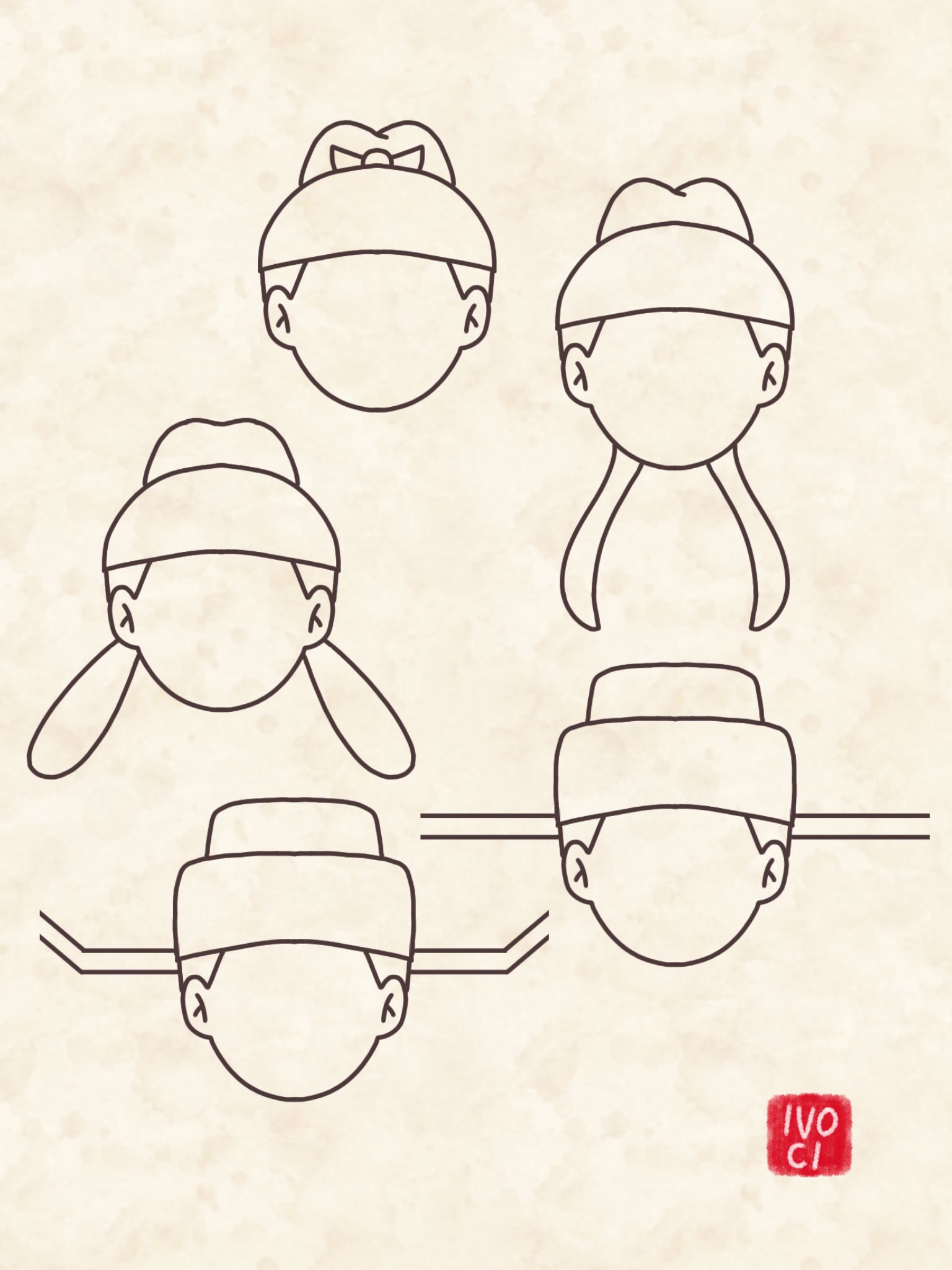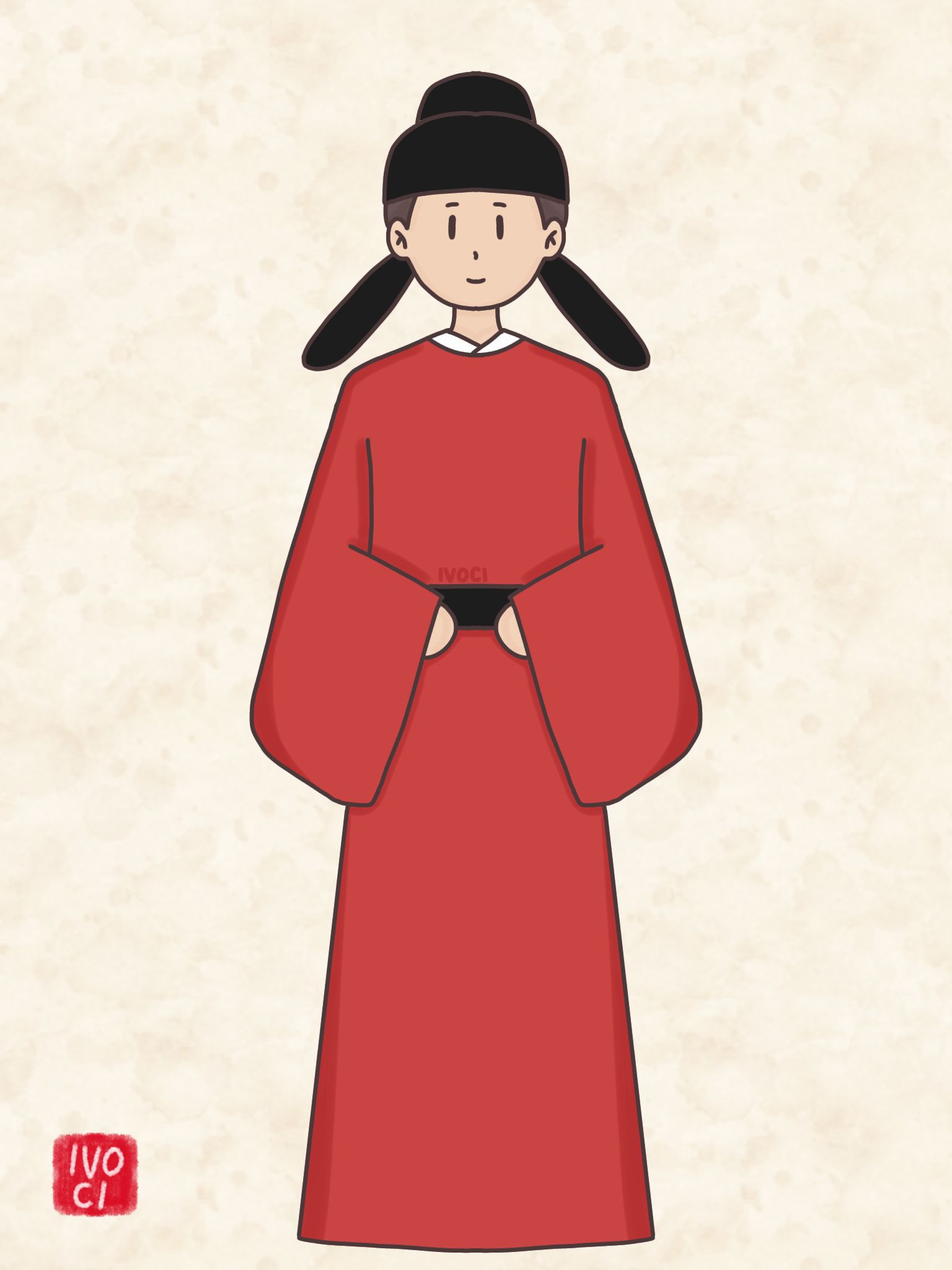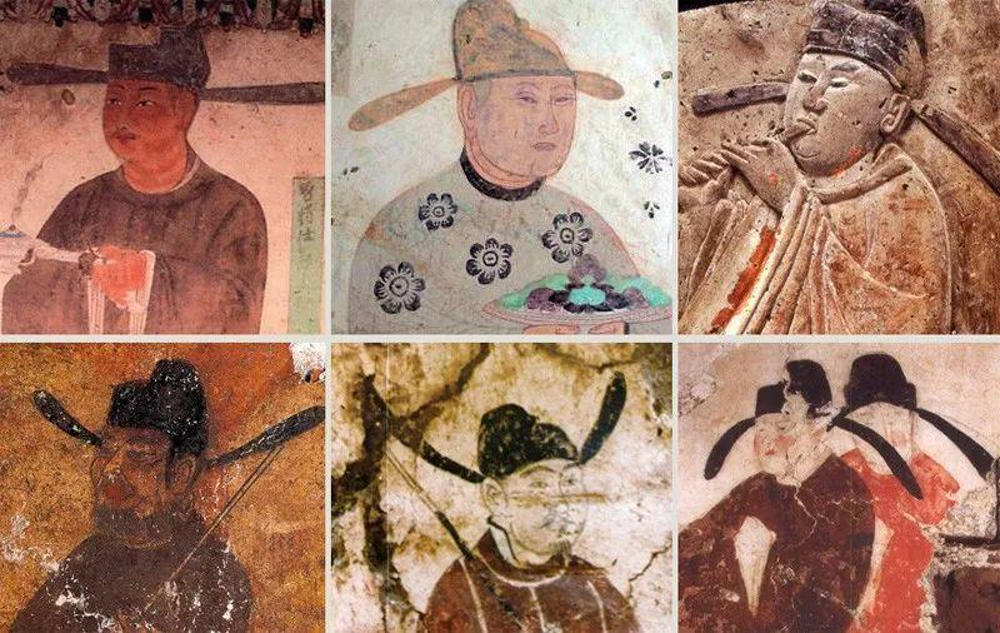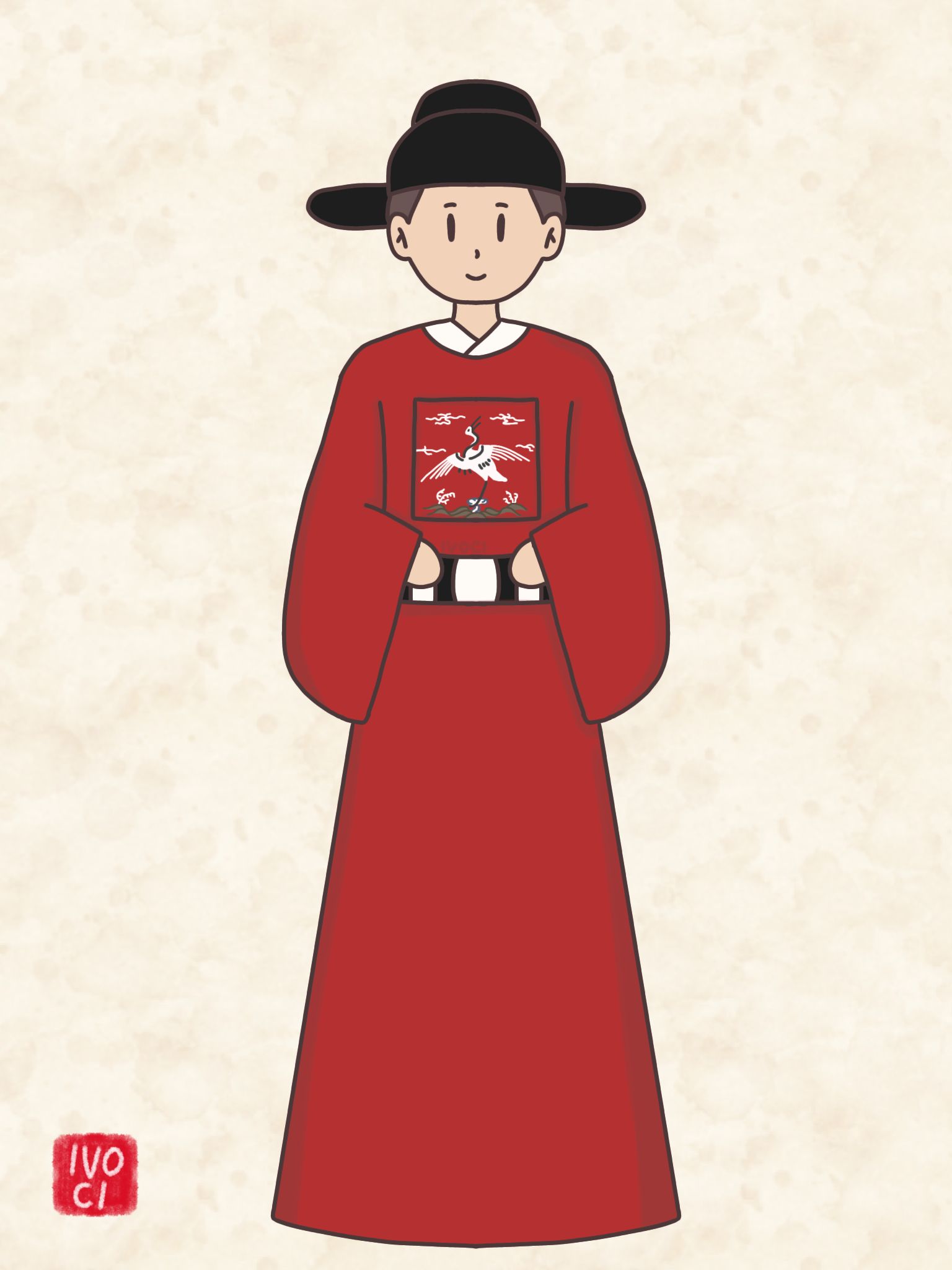Futou (Chinese: 幞头 ; pinyin: fú tóu) is one of the most important forms of headdress in ancient China with a history of over a thousand years.
Futou first appeared in the Northern Zhou dynasty under Emperor Wu where it became prevalent.
Futou was also commonly worn in the Tang and Song dynasties.
Futou is usually worn by government officials. Futou was originally a turban-like head covering that was tied behind the wearer’s head, the two corners opposite each other so that it served as decoration.
Jinzi (Chinese: 巾子 ; pinyin: jīn zi) refers to the layers used in the futou. Jinzi began to be used in 614 AD, and the aim was to make the futou look straighter and prettier.
From the Sui to Ming dynasties, futou evolved and developed based on fujin.
Fujin (Chinese: 幅巾 ; pinyin: fú jīn) is a type of guanmao, a male traditional headgear generally made from a piece of black fabric.
Futou finally comes in various shapes and styles.
The shape of the futou worn by government officials in the Song and Ming dynasties was based on the futou of the Tang dynasty which was their predecessor.
The futou was also introduced in Unified Silla and Balhae and continued to be worn by its government officials into late Joseon.
Futou with jinzi was also introduced in the Sogdian region of Central Asia and spread to the West via the Xinjiang region.
Futou with jinzi were also introduced in Japan during the Nara period through Prince Shōtaku.
Đại Cồ Việt was introduced to the futou in the late 10th century and adapted various iterations from Early Lê to the Nguyễn dynasty.
History
Wei, Jin, North and South Dynasties
The origins of the futou in China can be traced back to the reign of Emperor Wu of Northern Zhou, who wrapped his head in a futou with four ribbons, called sijiao (Chinese: 四脚 ; pinyin: sì jiǎo ; lit. ‘four wings/legs’) or zheshangjing (Chinese: 折上巾 ; pinyin: zhé shàng jīn ; lit. ‘folded scarf’).
Two of the ribbons are tied at the back and left hanging, while the other two are tied upside down at the top of the head.
According to Tongdian, Emperor Wu created sijiao by cutting fujin.
According to ancient texts, Emperor Wu created futou to protect the hair of his generals and soldiers in battle.
Futou first appeared as a type of handkerchief that was made by cutting a piece of muslin cloth into suitable sizes and by attaching four ribbons long and wide at each corner of the cloth like four wings.
This futou is large enough to completely cover the wearer’s hair, and when worn, the veil must be placed over the wearer’s head.
Two of these ribbons are tied across the forehead while the other two are tied at the back of the wearer’s head and left hanging. Before the Sui dynasty, the futou was a piece of black cloth.
Sui and Tang dynasties
Before the Song dynasty, futou were mostly made of black muslin.
In the early Tang dynasty, the futou was sijiaoruanjin (Chinese: 四脚软巾 ; pinyin: sì jiǎo ruǎn jīn ; lit. ‘four-winged soft scarf’), in which the four ribbons were allowed to hang after being tied.
Later, the early minister of the Tang dynasty, Ma Zhou, was the first to use a square handkerchief to tie the futou and was also the one to add layers to shape the futou to make it more beautiful.
Layers added to the inside of the futou from 614 AD are called jinzi (Chinese: 巾子; pinyin: jīnzi).
Jinzi is used to make the futou look straighter and prettier in terms of appearance.
Once cut into the desired shape, the jinzi is painted black with lacquer and then coated on the futou.
Jinzi is made with soft, light tung wood and with other materials such as bamboo strips, silk, and leather.
It is also possible to cover the futou with a mount-shaped item made of paulownia / tongmuweiguan (Chinese: 桐木为冠 ; pinyin: tóng mù wéi guān) on the front.
The step-by-step process for wearing a futou with a jinzi is tying the hair up to the topknot, followed by covering the topknot with a hard layer, wrapping the head and jinzi in a square-shaped black cloth, and finally tying the cloth in the desired style.
Futou with jinzi later became the standard form of futou in the early Tang dynasty.
Over time, the futou with jinzi was further developed, and ribbons were tied to each corner of the turban to make it more decorative than before, two ribbons were tied over the head while the back ribbon was tied and allowed to hang freely.
Yingwangboyang (Chinese: 英王踣样 ; pinyin: yīng wáng bó yàng), a futou with a large and advanced jinzi top, was invented by Emperor Zhongzong and became prevalent during his reign when he presented this type of futou to his officials.
During the reign of Emperor Xuanzong, neiyang (Chinese: 内样 ; pinyin: nèi yàng), futou with small and round jinzi became popular around 726 AD.
Also, by adding wire or silk threads inside the additional ribbon, the futou can take on different shapes and styles depending on the wishes of the wearer.
Five Dynasties and Ten Kingdoms Period
In the Five Dynasties period, more styles of futou were created including those with wide wings that look like fans or banana leaves that surround the front of the head and futou with curved wings that point upwards before bending downwards.
During Later Jin, Emperor Liu Min used a zhijiaofuto with straighter and longer wings.
The Song dynasty later maintained the tradition of using this style of futou as a standard.
It is also attested in the Song Shi that the futou has been straight and flat since the Five Dynasties period.
Song dynasty
Futou were very popular in the Song dynasty and generally worn by all walks of life from commoners to emperors wearing futou.
During the Song dynasty, black muslin, which was mainly used for making futou, was replaced by other materials, such as lacquered muslin.
The futou can also be found with a support made of wood, so it can look like a hat in many styles.
All futou in the Song dynasty had hard wings.
According to Song Shi, zhijiaofuto became the standard form of futou in the Song dynasty for emperors and officials on all occasions, except when they had to take the carriage.
The futou worn by officials of the Song dynasty had long, leaning wings, it was extended by having two hard bands made of iron wire or bamboo strips attached to the back of the futou. It was created to prevent officials from whispering to each other during palace audiences with the Emperor.
On some special occasions (e.g. imperial court banquets, or longevity ceremonies held for the royal family), officials of the Song court would place flowers on their futou.
Liao dynasty
In the Liao dynasty, led by the Khitan, the Khitan shaved their heads in a style called kunfa and wore light felt hats or helmets more suitable for horseback riding than lacquered futou.
However, the futou did not disappear in this period and continued to be depicted in Liao dynasty tomb murals.
Yuan dynasty
In the Yuan dynasty led by the Mongols, futou continued to be worn since the Yuan dynasty court followed the Song dynasty standards regarding formal dress.
Ming dynasty
The Ming dynasty maintained the tradition of using straight-winged futou, however, the shape of the futou worn in the Ming dynasty was different from that worn in the Song dynasty.
The wings got shorter with time and some of these futou became less than forty centimeters.
Forty centimeters long painted futou linen with straight wings was worn by military and civil officials on official business according to Ming Shi.
The Ming dynasty futou wings were not completely straight and had curved ends.






Leave a Reply